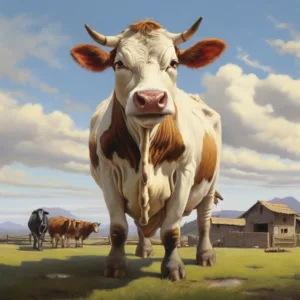Unveil the surprising truth behind a cow’s digestive system! Explore the four stomach chambers, unravel the mystery of rumination, and discover fascinating insights into bovine digestion. Get ready for an eye-opening journey into the world of cows!
Introduction:
Curious about the intricate workings of a cow’s stomach? Join us as we unveil the surprising truth behind the unique digestive system of these gentle creatures. From the rumen to the abomasum, each stomach chamber plays a crucial role in processing their plant-based diet. Get ready for a deep dive into the fascinating world of bovine digestion!
The Four-Chambered Marvel
Rumen: The Fermentation Vat Ever wondered how cows break down tough plant materials? The rumen, the largest stomach chamber, acts as a fermentation vat where microbes work their magic. This initial breakdown of complex carbohydrates sets the stage for efficient digestion.
Reticulum: Assisting in Breakdown Working hand in hand with the rumen, the reticulum aids in the breakdown process and helps form cud. Cud, the result of regurgitated and re-chewed food, is a fascinating aspect of a cow’s digestive strategy.
Omasum: The Filtration System The omasum serves as a crucial filtration system, absorbing water and essential nutrients from the partially digested food. This chamber ensures that moisture is efficiently extracted before the material moves to the next stage.
Abomasum: The True Stomach Often referred to as the “true stomach,” the abomasum functions similarly to a monogastric animal’s stomach. It secretes gastric juices that further break down proteins and aid in nutrient absorption.
The Journey of Ingestion
- Ingestion: Cows graze on grass and forage, consuming large quantities during each feeding session.
- Rumination: The ingested material enters the rumen, initiating microbial fermentation. Cud, a crucial part of the process, is regurgitated and re-chewed.
- Filtration: The partially fermented material passes through the reticulum and omasum, undergoing further filtration.
- True Digestion: The processed material reaches the abomasum, where gastric juices aid in the breakdown of proteins and other nutrients.

The Surprising Truth: How Many Stomachs Does A Cow Have?
Contrary to common belief, cows have four stomachs, each serving a unique purpose in the digestion process. Understanding the intricacies of their four-chambered stomach provides valuable insights into their nutritional needs and overall well-being.
FAQs: Clarifying Common Queries
How does the four-chambered stomach benefit cows?
The four-chambered stomach enhances the efficiency of digesting fibrous plant material, allowing cows to extract maximum nutrients from their diet.
Is regurgitation normal for cows?
Yes, regurgitation and re-chewing of cud are vital aspects of a cow’s digestive process, aiding in further breakdown of ingested material.
Why is the omasum crucial in digestion?
The omasum acts as a key filtration point, ensuring that water is efficiently absorbed before the material progresses to the true stomach for final digestion.
What is the role of microbial fermentation in the rumen?
Microbial fermentation in the rumen is essential for breaking down complex carbohydrates in the cow’s diet, making it easier for the animal to absorb nutrients.
Can cows survive on a solely plant-based diet?
Yes, cows are ruminant animals designed to thrive on a plant-based diet. Their complex stomach allows them to efficiently digest fibrous plant materials.
How long does the entire digestion process take in a cow?
The complete digestion process in a cow can take anywhere from 70 to 100 hours, depending on factors like the type of feed and the specific digestive dynamics of the individual cow.
Conclusion
Unraveling the surprising truth behind a cow’s stomachs provides a newfound appreciation for these remarkable animals. From the intricate fermentation processes to the unique filtration system, every aspect of their digestive system contributes to their overall well-being. The next time you encounter a cow grazing in the pasture, remember the complex journey happening within their four-chambered stomachs.

